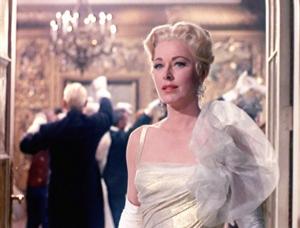(Reuters) – Eleanor Parker, a Hollywood leading lady of the 1940s and 1950s and three-time Oscar nominee who starred alongside big names including Frank Sinatra and Kirk Douglas and later appeared as the baroness in the blockbuster “The Sound of Music,” has died. She was 91.
Parker, whose ability to tackle many kinds of roles including heavy drama and light comedy earned her the nickname the “woman of a thousand faces,” died of complications from pneumonia at a medical facility near her home in Palm Springs, California, on Monday, said family friend Richard Gale.
The radiant redhead from Ohio never won an Academy Award but was nominated as best actress three times in a five-year period. Those nominations came for playing a horrified prison inmate in “Caged” (1950), the neglected wife of a cop portrayed by Douglas in director William Wyler’s “Detective Story” (1951), and as polio-stricken opera singer Marjorie Lawrence in “Interrupted Melody” (1955) with Glenn Ford.

One of her best roles came in another 1955 film, portraying drug addict Sinatra’s spiteful crippled wife in director Otto Preminger’s “The Man With the Golden Arm.” Parker also co-starred with Sinatra in director Frank Capra’s “A Hole in the Head” (1959).
“He can be a bad boy but he does it charmingly,” Parker said of Sinatra in a 1969 Baltimore Sun interview.
She had a secondary role, playing the child-hating Baroness Elsa Schraeder, in her most enduring movie — the 1965 musical “The Sound of Music” starring Julie Andrews and Christopher Plummer. It became the highest grossing film to date.
Parker’s co-stars included some of the top leading men in Hollywood: Clark Gable (“The King and Four Queens”), Humphrey Bogart (“Chain Lightning”), Errol Flynn (“Never Say Goodbye” and “Escape Me Never”), Charlton Heston (“The Naked Jungle”), Robert Mitchum (“Home from the Hill”), Ronald Reagan (“The Voice of the Turtle”), as well as Sinatra, Douglas and Ford.
‘HE USED TO CALL ME GRANDMA’
Parker fondly recalled working with the rakish Flynn when she was in her mid-20s.
“I guess I was a little old-fashioned for Errol. He used to call me ‘Grandma,'” Parker was quoted as saying in Doug McClelland’s 2003 biography, “Eleanor Parker: Woman of a Thousand Faces.”
“Once, while we were waiting for a scene to be set up, he was holding a glass of what looked like milk. I was thirsty from rehearsing and asked for a sip. I nearly choked! The drink was mostly gin. But I liked Errol. He treated you the way you wanted to be treated,” she said.
Parker’s last starring role came in “Madison Avenue” (1962), and her last movie was the Farrah Fawcett stinker “Sunburn” (1979).
Despite her reputation as a versatile and respected actress who worked with A-list directors and top actors in about three dozen movies, Parker’s fame diminished as the decades passed.
“I’ve often wondered why she did not then and does not now receive greater recognition,” screenwriter William Ludwig wrote in a forward for McClelland’s biography. “Two reasons occur to me. She never played Eleanor Parker but was always the character in the script. Audiences did not think of her but thought of the character.
“The other reason, as I think about it, is that she so thoroughly prepared a role that she made her work look easy, the way Fred Astaire made his dance routines look easy. The sweat is never visible on the screen. It comes in preparation, not in performance,” said Ludwig, who won an Academy Award for his script for Parker’s “Interrupted Melody.”
Parker was born to a middle-class family on June 26, 1922, in Cedarville, Ohio. She started acting in school plays as a girl and later moved to California to study acting at the Pasadena Playhouse. At the playhouse, while merely sitting in the audience during a show, she was spotted by a studio scout and was signed by Warner Bros. in 1941.
Parker was married four times and had four children.
